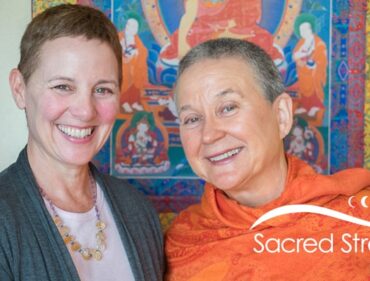Article: The Path of Service and Initiation
By Isa Gucciardi, Ph.D.
Editors’ Note: Keynote speech from “A Practitioner Summit: Walking the Path of Service”
Summary: Birth holds deeper possibilities for transformation for expectant mothers, their partners, birth professionals, and society than is usually acknowledged. It is, therefore, more important than is usually acknowledged to respect and safeguard the birth environment.
Thank you for inviting me here this evening to speak to you. I have known about your group for many years now, and I have always appreciated the efforts you have made to change the way women and families experience birth in the Bay Area.
I think it might be easy for us in the Bay Area to take the kind of resources and alternatives to birth that each of you provides for granted. But all we need to do is to listen to the news to understand how women’s reproductive rights are under siege both in this country and abroad. Families have choices here in the Bay Area that families across the country and across the globe do not have. Not only do we live in a place where the process of becoming a parent can be viewed as a process of education, but we live in a culture where that education is valued and available.
You are on the forefront of the effort to provide that education to help families make more conscious choices and provide the earth with a new generation of children who are raised in environments where there is an abundance of choice, resources, and possibility. The value of your work cannot be overemphasized, and so it is a privilege for me to be able to address you.
This evening I am going to speak about our roles as healers and the importance of understanding how, as healers, we must understand our work as guides – guides into the understanding of the processes of initiation that birth and parenting provide. As many of you know, as we are guiding our patients, clients, and students in making choices about fertility, birthing, and parenting, we are actually preparing them to undergo profound change.
Change, and managing change, is the essence of the process of initiation. The processes of initiation are processes that are poorly understood in the modern environment. Even though people continue to undergo initiation after initiation as they walk the path of their lives – just as people in more traditional societies have always done – there is a poor understanding of what initiation is. The difference is that we do not have the carefully considered rituals that one finds in traditional cultures that are designed to direct the processes of initiation of its members.
The upsides of a less tradition-bound culture, such as ours, are evident in the freedoms and choices women, children, and families can participate in. Women are not bound by cultural mandate to mate with men they have no resonance with. Children are not forced into livelihoods dictated by the station of their birth. Men can choose to eschew the role of householder and still have relevance to the society. And, at least in the Bay Area, healers can educate themselves in a wide range of healing modalities and bring them to those they serve without – hopefully – being ridiculed by the mainstream or bound by the superstition of poorly considered, yet widely accepted, practices.
But the downsides of a less tradition-bound society are perhaps less evident when it comes to the proper management of the processes of initiation. Even the word is foreign to some of us. Many of you may only associate the word with fraternity hazing rituals or violent acts that young people must commit to be admitted to the ranks of a particular gang. But the process of initiation is fundamental to the human experience.
Every human being engages in the processes of initiation in the course of living their lives, but very few modern people understand that they are engaged in the process of initiation as they are born, as they meet puberty, as they meet the other in sexual encounter, as they give birth, as they enter menopause (and yes, men do enter their own form of menopause), and as they continue on their path of initiation as they lose those they love, and as they, themselves, die. A human being’s biology dictates and directs the entry into initiation, but it is up to us, as healers, ministers, and educators, to help direct the power of the initiatory process in such a way as to help benefit, enrich, and enlighten those we serve.
This mandate that we have as healers, ministers, and educators has not always been met with the greatest possible integrity by those in our professions. For some, this failure is an act of omission. They simply do not or have not understood the sacred trust they have been charged with in guiding others through their rites of passage. For others, this failure is an act of commission, and even, at times, a bald-faced grab for power that is not rightly theirs. To correct any way in which we might be out of integrity in our relationship to guiding the process of others’ initiations, we have to become more conscious of our motivation to serve.
Because we live in a cultural environment of so much relative freedom, we have the good fortune to be able to participate in the process of the evolution of consciousness and we are even more fortunate to be called to assist others in taking steps toward their own evolution in their well-being. We must take the sacred trust that is offered us very, very seriously. We must examine our motivations for becoming healers, ministers, and educators. We must do our work. Our work is the work that we do to bring our deepest intentions into the light. We must heal anything within us that would cause us to thirst for another’s power rather than seek to empower those we serve. We must remove the obstacles to our own power that lies at the center of our being – and we must commit to acting from a place of integrity, resolution, courage, and purity of intention at all times. This is not an easy task. We must dig deeply. We must be willing to look into our darkest recesses – even in places we may have not wanted to see. And we must meet these places bravely in order to begin to understand the processes of our own initiation and allow ourselves to move through these initiations with clarity and a sense of purpose. In this way we can become the proper vehicles to help manage and guide the initiatory processes of others.
So let’s look more closely at the nature of initiation and the characteristics of initiations. First, initiations are intimately tied with change. They bring the initiate from one form of being into a new state of being. Initiations accomplish this task by putting the initiate through a series of experiences that challenge the status quo, the way things are.
Initiates must render themselves vulnerable to these initiatory processes in order for the initiation to become complete – and the power in that vulnerability must be managed carefully and thoughtfully. This is a subtle and poorly understood task. Many people going through initiations and many people managing initiations do not have a clear understanding of the nature of the power and the nature of the vulnerability that is at the heart of initiation. For an initiation to be successful, that power and that vulnerability must be safeguarded and dedicated to the initiate.
For women, their biology dictates the initiation processes that define their experience as human beings in a very clear way. This is a simple statement, but profound in its implications. This truth and its implications are very poorly understood by modern people, and in traditional cultures it is also not well articulated. At least not in this way. I have not, in all my studies in anthropology, found a culture which manages initiation with an articulated understanding of the role of biology in spiritual evolution.
So, I will say it again: For a woman, her biology dictates the initiation processes that define her experience as a human being in a very clear way. The way the initiations of her biology are met determine a woman’s experience as a human being – and ultimately, the way these initiations are met define and articulate her spiritual path. Further, the way each initiation is met defines and dictates the way subsequent initiations are met. So, a culture which supports the dedication of a woman’s power to her as she passes from one initiation to the next – from her own birth, to puberty, to the sexual encounter with the other, to birth and to death will look very different from a culture that seeks to co-opt the power that is released as a woman passes from one form of being to another. A woman’s experience of her biology, her spirituality, and herself as a human being will be different as well.
For instance, a woman who has had a cliterectomy at puberty, been sold to her husband without a say in her fate, forced to bear many children, and then who dies in childbirth has a very different experience of her path through life, and a very different set of spiritual needs as a result, as compared to a woman who has been celebrated for her new power at the onset of menstruation, who has chosen her first and subsequent mates, and has chosen the number of children she bears and then dies in childbirth. The last initiation, that of death, is bound to be met in an entirely different way by each woman. This difference lies in the success or failure of the previous initiations to death and in the directing of the power of those initiations into that last initiation. The first woman dies with a series of incomplete or interrupted initiations behind her which will affect her spiritual evolution going forward. The second woman meets death with the power of her previous initiations rededicated to her – and this will have a different effect on her spiritual evolution going forward.
So, I will say again: the way a woman meets the initiations of her biology determines her experience as a human being – and ultimately defines and articulates her spiritual path.
For those of us who are birth professionals, then, these truths must resound within us the way thunder rolls across a darkened sky. We must understand the profound and important role we play as we assist women in moving through one of the major initiatory processes her biology drives her toward – that of giving birth.
I will speak more about this momentous responsibility in a moment.
For men, these processes of initiation are also evidenced by their biology. But men’s biological processes are generally less dramatic because most of the drama of procreation lies within women’s biological processes. In both traditional and non-traditional cultures, men often have to invent initiatory processes in the form of elaborate rituals that challenge their status quo and that break down old forms and create new ones because their bodies are not driving them every month from one form to another the way women’s bodies do. The sun dance in the Lakota tradition, ritual war games in the Mayan tradition, and genital mutilation in the Hebraic and other traditions are examples of these culturally defined initiatory processes that men engage in to try to match the driving nature of women’s biology as it pushes her toward the encounter with her spiritual path and her spiritual truth.
In traditional cultures, the defining qualities of the cultures themselves come out of the way each culture meets and manages the initiatory processes of its individual members through its rituals. Initiatory rituals can be very elaborate, very defined, and very defining. These structures are, on the one hand, good management tools to direct and hold the power of the initiatory process. Unfortunately, most cultural structures are designed to direct the power that is released in the initiatory process into the society’s structures, rather than into the initiate where it belongs. This binds the individual to the societal structures and ensures the continuation of them. For instance, puberty rites for young women in every culture are very clear: The power that is being released as the old forms of girlhood fall away and as the new forms of womanhood emerge do not belong to the female. The rituals in traditional cultures around female puberty almost universally manage the transfer of the power of this initiation by transferring that power from one male to another – from the father to the husband. Weddings, in Western culture, still do this. “Who presents this woman in marriage?” is always answered by the father as he literally hands his daughter over to her husband.
The biological power of females is almost never allowed to rest with the female in traditional or modern cultures as she moves from one initiatory process to another. One reason I began teaching the classes I teach on the Sacred Feminine and on Tracking Spirit in the Birth Environment is to change this fact.
As I mentioned earlier, there are advantages and disadvantages to functioning in a culture where societal structures are weakened. One disadvantage is that cultural structures around the management of the power of the initiatory processes are weakened and ill-defined. But for our purposes – or at least my purposes, and I think I do speak for more than one of you – this is also an advantage.
The disadvantage is that the power of the initiatory processes is lost and unmanaged – even to the society’s structures that, when intact, are very quick to dedicate the power of the individual’s initiatory process to the society’s priorities. The power released in initiation is highly creatively charged. Wherever creative power is poorly managed, you will find opportunists. Opportunists are those that do not have power of their own or do not have access to their own power – and they seek to feed off the power of others.
Another big disadvantage to an environment where societal structures are weakened is that the creative power held in initiatory processes is not dedicated to the individual in any way – even if that way is just to bind the individual to the societal structures through the rituals the society places around initiation. One very serious effect is that the power of the initiation process is lost to the individual, and the individual is crippled, without the support of the society, as he or she moves into all subsequent initiations. But a more serious effect is that the poorly managed power of the initiation, as I said, becomes available to opportunists.
This set of realities, is, in my opinion, the reason for the crisis in spiritual experience that modern humans are experiencing generally. When we are looking at the practices around birthing specifically, we see very clearly that the crisis we find ourselves in around birth is due to this same set of realities. We have women who have no idea that they have been engaged in a spiritual path driven by their biology. They have no idea that they have been moving through one initiation process after another – as they have been moving through their own birth, through puberty, through the monthly menses, through the sexual encounter with the other. It is not likely that they would be able to meet the further initiations around birth with grace and fortitude given the total ignorance regarding the nature of initiation on the part of ministers, teachers, doctors and other birth professionals who are supposed to be guiding them. Additionally, their partners may be even less informed about the initiations their lives have been bringing them to, particularly if their biology has not been focusing them on the initiations of birth in the way a woman’s biology does. So everyone enters the initiations around birth in a very disorganized way.
When it comes to birth, I think it is important to remember that every aspect of a woman’s or a couple’s engagement with the birth process is an initiation, even in situations where the woman or the couple is not able to conceive, or in situations where there is a miscarriage or even a death of a child. I think this is an important understanding to keep in mind, particularly when we are trying assist women or couples who are experiencing fertility challenges. In the drive to fulfill the desire to have a child, couples may push across one obstacle after another and still not be able to have a child. This is not a failed initiation. The process of coming up against a situation where one’s heart’s desire is defeated and learning how to meet that defeat gracefully can be its own initiation. And death and loss, and the grief they engender, contain deep and powerful engines that force the initiate to change from one way of being to another in ways that must be deeply examined in order to be understood.
It is especially important to understand the gravity of the situation that is created when a couples’ quest to have a child brings them into contact with so many potential opportunists. We have opportunists in the form of medical corporations, pharmaceutical companies, insurance companies, medical equipment companies, and birth professionals who are actively preying on the power of women as they are rendered vulnerable by the processes of the initiation of birth. There is no doubt that this is a terrible state of affairs.
But it is also an opportunity. It is an opportunity for those of us who are aware of the roots of the crisis – and who are aware that the crisis is actually a good thing because it indicates that previously unassailable societal structures set in place around the management of the initiation of birth can be restructured. In the environment of the Bay Area, we have the opportunity to bring forward the depth of purpose that exists when birth is understood as an initiatory process. It is important to grasp this clearly and firmly. This understanding and depth of purpose is an important antidote to the helplessness we often find ourselves in when we try to meet the opportunists on the wrong battlefield. In the environment of the Bay Area, we do, in fact, have the opportunity to bring the depth of purpose that the understanding of birth as initiation is to the women and families we serve. This has the possibility of radically changing their experience, and our own experience as care providers.
As powerful as this will be for the women we serve, it has even more powerful implications for us as practitioners. We become more than a care provider if we understand that one of the most important roles that we as practitioners and birth professionals play is as a guide for the initiation of birth for the families we serve. We have the opportunity to create new structures around the initiation of birth. Structures that dedicate the power of the initiation of birth to the woman and her child – and to the father of the child, should he choose to participate in the initiatory process. This power does not have to be dedicated to corporations, societal structures, or familial structures that only seek the power of this most important initiation for themselves. We can create structures that safeguard this power – and we can ensure that this power is dedicated only to the initiates. If we can meet this challenge, we can restore sanity – not only to the birth environment, but also to the society in general – as power returns where it belongs, and as structures which do not have their own access to power are revealed for what they are. Then, the power that these opportunistic structures have been misdirecting toward their own unwholesome goals can be taken from them to be directed where it belongs.
This is an important challenge for us to meet with all the intelligence and dedication to the service of the power of sanity we can call upon. It is therefore imperative that we understand our own relationship to our own initiatory process. We must understand our lives as the spiritual path they are, and we must understand our own biology for the guide it is. We must understand where and how we have the lost power in our own incomplete or interrupted initiation processes, and we must undertake the path to retrieve that power and dedicate it to ourselves – and dedicate ourselves to it. We must ask: How have I met the challenges of my own birth, my own entrance into puberty, my relationship to menstruation, my own first and subsequent sexual encounters with the other, my own choices or experience around giving birth? How do I hold menopause? And how do I hold death?
I encourage you to embark on the quest to answer these questions so that you can best and most powerfully serve those you are in service to. The path of the healer is a path of healing. You must heal yourself. You must learn what your own sources of power are – and what obstacles you might have to them – if you are going to fully understand what it is to heal and empower others. If you undertake this quest, you can participate in the restructuring of the very essence of material experience for all humans. You can participate in the restructuring of the initiatory process of birth. In so doing, you can change human experience for those you serve at a very fundamental level. You can participate in the creation of new structures which support and empower the initiate, and thereby strengthen society in ways that are impossible when the societal structures are designed to just steal the power of the initiate for its own uses. You can have the opportunity to fully participate in this marvelous moment where the restructuring of the fundamental aspects of human experience is possible.
I wish you well on your journey, and it is a privilege to have had this moment to be a part of it.
LIKE THIS ARTICLE? SIGN UP FOR FREE UPDATES!



